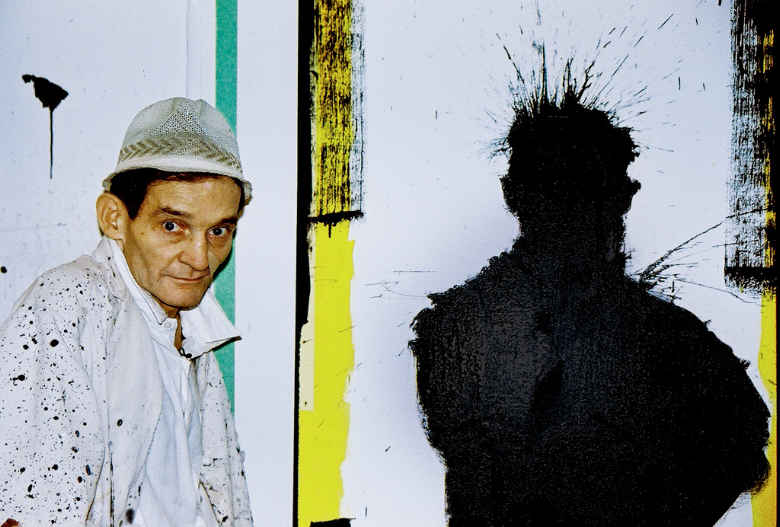In the beginning, there was Richard Hambleton.
Let me quote from the great book New, Used and Improved, written in 1987 by Peter Frank and Michael McKenzie:
"A gaunt, elusive painter named Richard Hambleton tattoed the urban landscape with a pair of outdoor multiple works: Image Mass Murder and Shadows. If Hambleton's work can be classified as site-specific art, the sites they show us reveal the atmosphere that was enveloping American cities in the '70's. It was a time when people feared to leave their homes, anticipating mugging, rape, murder at every street corner.
For Image Mass Murder, Hambleton drove, bused, and hitchhiked to cities across the country, tracing the fallen human form on urban sidewalks with white paint, the way the police do to mark the site of a murder. Hambleton did this entirely anonymously, without prior or subsequent announcement, and such anonymity only provoke mass-media coverage.
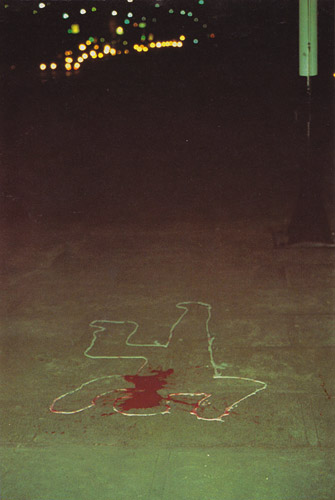
(New York, 1977)
After that succes, Hambleton began painting 'shadows' in a painterly, even splattered manner on the walls of buildings in major cities. If the sidewalk marking of Image Mass Murder elicited surprise and morbid curiosity, the eerie Shadows exploited people's deeply felt anxieties about the city's streets. Almost everyone who lived in New York at that time has a story to tell about the night they turned a corner to see a Hambleton shadow in a parking lot or on a side street.
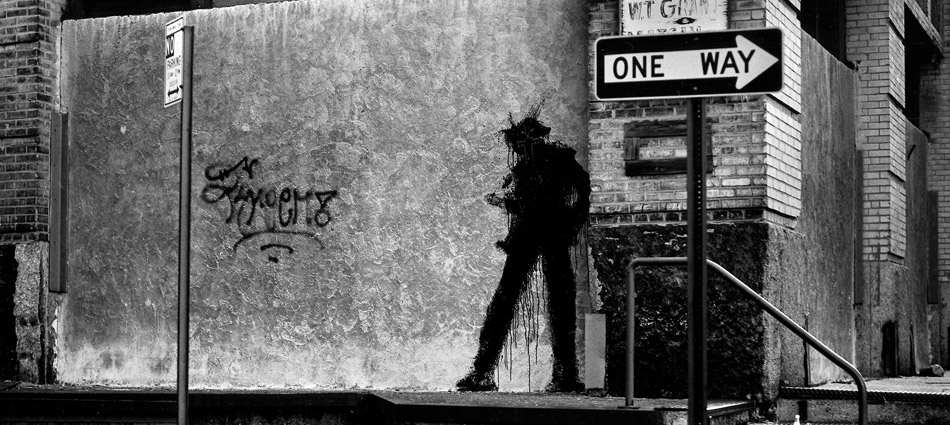
Hambleton emerged from the shadows with full-length photographs of himself, affixed were the earlier shadows had or could have been painted, and with a touring show documenting Image Mass Murder."
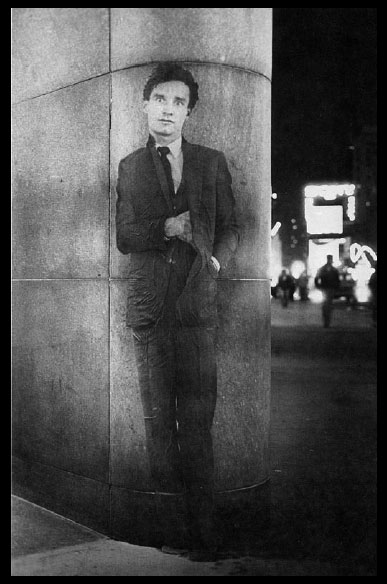
(Times Square, NYC, 1980)
About these photographs, Alan Schwatzman wrote in the seminal book Street Art (1985): "In 1980 Hambleton pasted 800 life-sized diazo prints of the artist respectably attired in Napoleonic pose, with a crazed sparkle in his eyes, like a stranger intruding on a sidewalk tete-a-tete by his menacing stare, were placed by Hambleton on urban walls in ten cities... The upwardly mobile figure was produced by black-line printing, a process akin to blueprinting, which results in the entire image fading uniformly over a three-month period, and printed on paper that stretched when moistened to conform to the wall's texture, thus leaving behind a white "ghost". He gave the project titles: I Only Have Eyes for You, Putting Yourself Up for Abuse, and Spreading Yourself Thin."
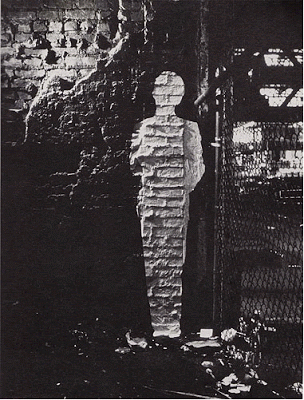
This is what Hambleton said about his earlier outdoor work: "I'm dealing with feelings and human emotions."
I'd say that's quite an understatement: his outdoor works are very powerful, and made viewers aware of their fear for violence, making them avoid dark alleys, parking lots and side streets.
Hambleton also remarked that his outdoor work was quite different from other street icons, such as Haring or Basquiat (using "Samo" as tag name): "Other artists put their work on the city, but what I paint on the walls is only part of the picture. The city psychologically completes the rest. People experience my paintings. They aren't simply exposed to them."
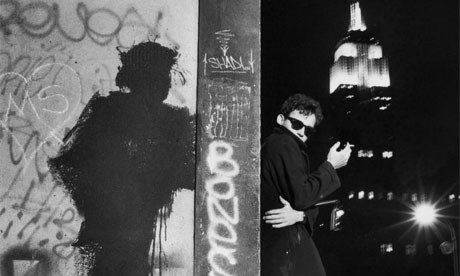
(RH with Shadow Figure, Lower East Side, NYC january 1st, 1984, 12AM, photograph by Susan Aimee Weinik).
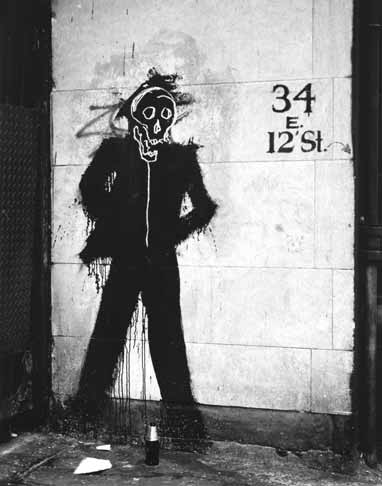
(Basquiat famously painted one of his iconic heads on a Hambleton Shadow Man, East Village 1982-1983)
After those initial years working on the streets, Hambleton moved to making gallery works, and exhibited widely in the eighties. In 1982 he had first solo exhibition in the USA (he was born in Canada, and was founder and co-director of the "Pumps" Center for Alternative Art in Vancouver, and The Furies, Canada's first punk band, played their first gig at a Hambleton show in 1976), at Alexander Miliken Gallery.
Over the years he 1982-1985 he exhibited in Germany, Holland (at Barbara Farber Gallery), Italy and Spain, and participated at many iconic group shows in New York: Times Square Show (1980), The Real Estate Show (1982), Terminal New York (1983).
Then, for almost 25 years, nothing.
Hambleton did not return on the New York scene until 2007, when he made a spectacular comeback: he showed his 'Beautiful Paintings' at the Woodward Gallery.
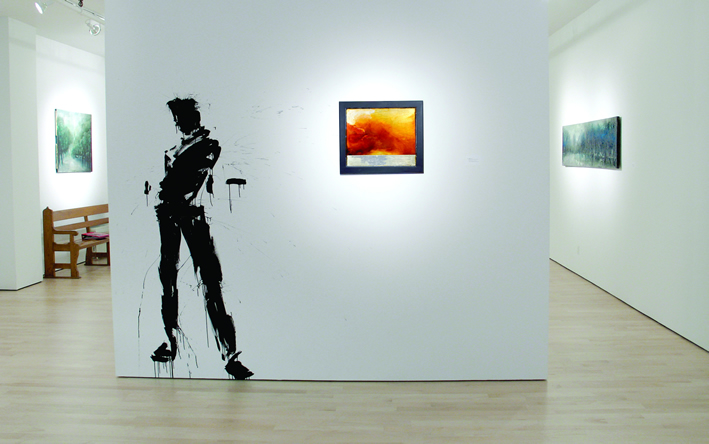
(A resting Shadow Man and on the right of it: Amber)
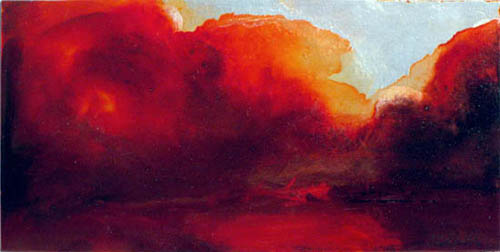
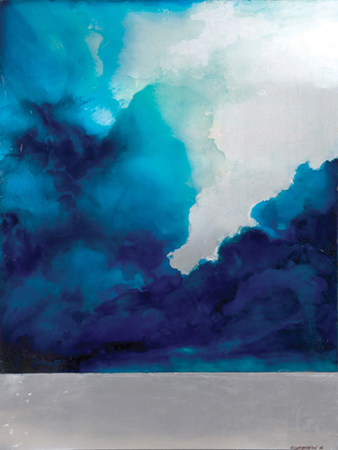
The "Beautiful Paintings" were beautiful indeed, and quite a departure from the early Shadow Man. David Ebony described some of the orange, blue and green works in Art in America: "Amber (2006) a medium-size panel made of varnish, tinted enamel and silver leaf on wood, exemplifies Hambletons more recent endeavors. Framed in thick, black-painted wood, the work features a golden palimpsest of pools of pigment and varnish in the upper area that suggests billowing storm clouds. A rectangular strip of silver leaf at the bottom hints at a horizon line and a glowing body of water.
Similar in composition as well as luminosity, Priscilla (2006) describes looming clouds of Prussian blue rising above a silver lake. In Pamela (2006), mellifluous pools of deep orange, yellow and white convey a Turner-esque ode to the sea. Here, it seems, rays of sunlight break through the clouds of shine upon a vast, red ocean.
An untitled 2007 painting, the largest work on view (about 3 by 61/2 feet), and perhaps the most ambitious, evokes a twilight landscape in summer. Deft and wispy brushstrokes suggest a verdant forest pressing along the banks of a misty river.
Despite their glowing surfaces and sumptuous materials, Hambleton's works manage to avoid a sense of preciousness or pretension. While riffing on the painterly vocabulary of the 19th-century American Luminists, Hambleton offered in this show a personal and poetic hallucination of nature."
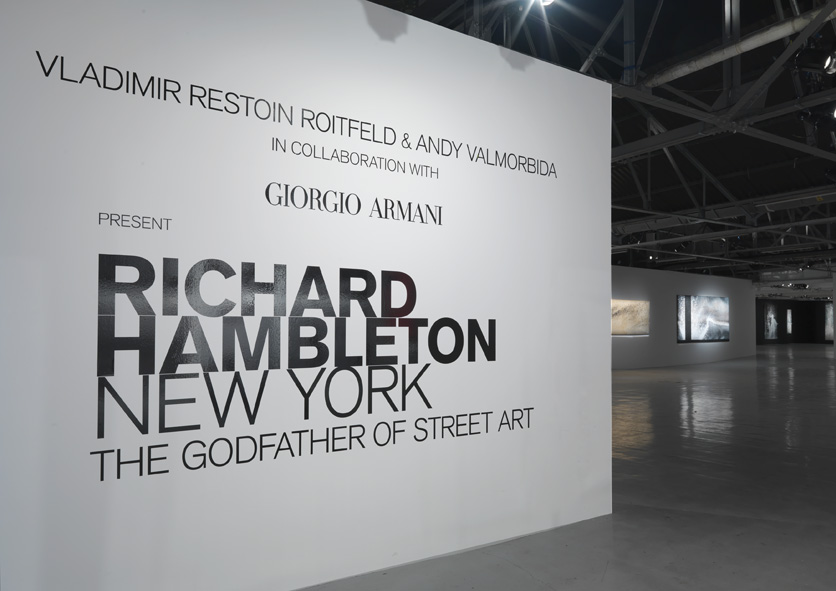
Enter Andy Valmorbida, Vladimir Restoin Roitfeld and Giorgio Armani. Two wealthy young men teamed up with designer Armani, in order to promote their 'rediscovery': Richard Hambleton.
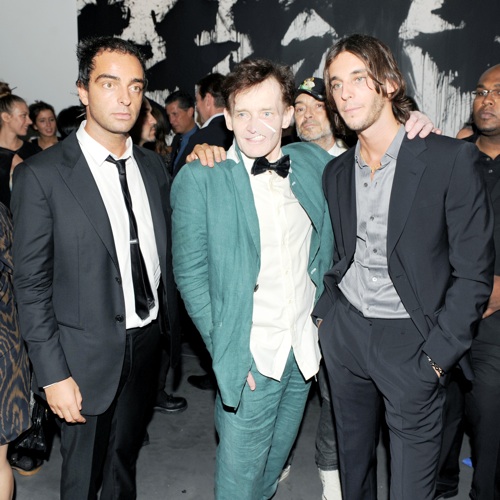
(Andy Valmorbida, Richard Hambleton, Vladimir Roitfeld)
In 2011, on September 10th, a big retrospective of Hambleton's works opened at the premises of Phillips de Pury in New York, coinciding with the fashion week (not surprising, Vlad Roitfeld was born in Paris, France. He is the son of Christian Restoin and Carine Roitfeld, French journalist, fashion stylist, and the former editor-in-chief of French Vogue).
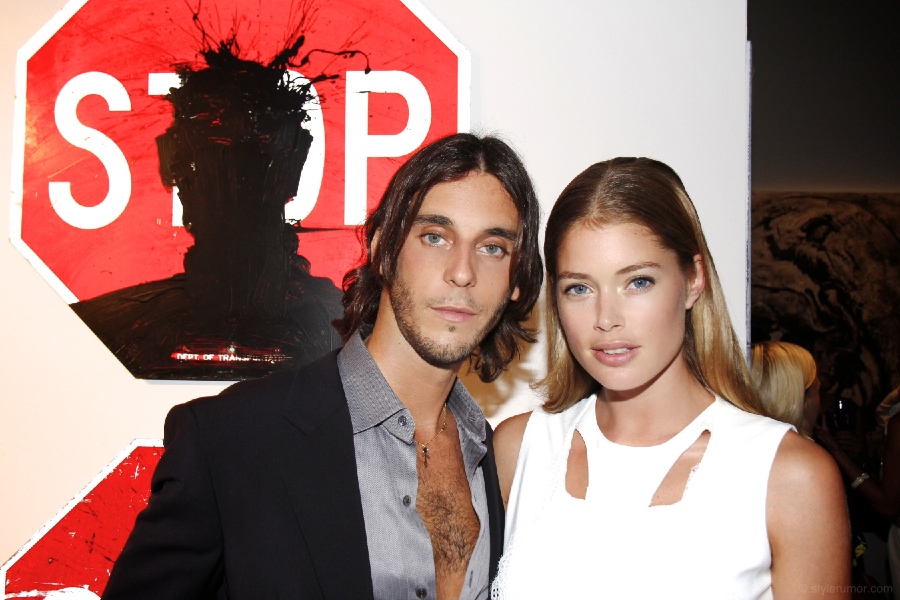
(Vladimir Roitfeld and Doutzen Kroes)
This is what (of course) Vogue wrote about the opening party (which I attended, in the company of Arnon Grunberg, whom I urged to purchase a work by Hambleton, but who declined): "Last night, Vladimir Restoin Roitfeld and Andy Valmorbida hosted an opening for artist Richard Hambleton in collaboration with Giorgio Armani. The party began at Phillips de Pury & Company uptown, where every fashion week attendee (it seemed) arrived to fete the final installment of a series of solo shows (which have been on view everywhere from Moscow to Cannes) curated by the two as well as to kick off fashion week in style.
Instead of taking arrival photos in front of a red carpet backdrop, models, artists, and editors struck a pose in front of a huge blue and white painting that looked like an abstract seascape. The crowd itself was a sea of talent: Doutzen Kroes in Givenchy, the Clarins sisters—each with a look all their own, Bar Refaeli, Alexa Chung, Michelle Harper, Monique Péan, Carine Roitfeld in Yves Saint Laurent, Gaia Repossi, Karolina Kurkova in a silver Salvatore Ferragamo suit, Alessandra Ambrosio in Pucci, and Margherita Missoni in a tea-length Missoni dress. And, the term “street style” was redefined inside, where dynamic portraits in drippy paint were rendered on stop signs, or mounted on the wall in just-so disarray, mimicking the quick curatorial style of a graffittied paste-up. (Hambleton has been called the “godfather of street art.” He’s the surviving member of the Keith Haring and Jean-Michel Basquiat days.) “We rediscovered Hambleton two years ago—he hadn’t done a show in 25 years—and to now be having a show in this venue is amazing,” Restoin Roitfeld said. “Ending in New York at Phillips de Pury is the cherry on top.”
The party continued at Indochine downtown, where nostalgic songs from bygone movie soundtracks (namely “You’re the One That I Want” from Grease and “Don’t You Forget About Me” from The Breakfast Club) led to some impromptu dancing. And late night, Missoni and Elisabeth von Thurn und Taxis took to the floor during Tom Petty’s “Learning to Fly,” while Roitfeld took a seat on top of a banquette with Bell and swayed to the music."
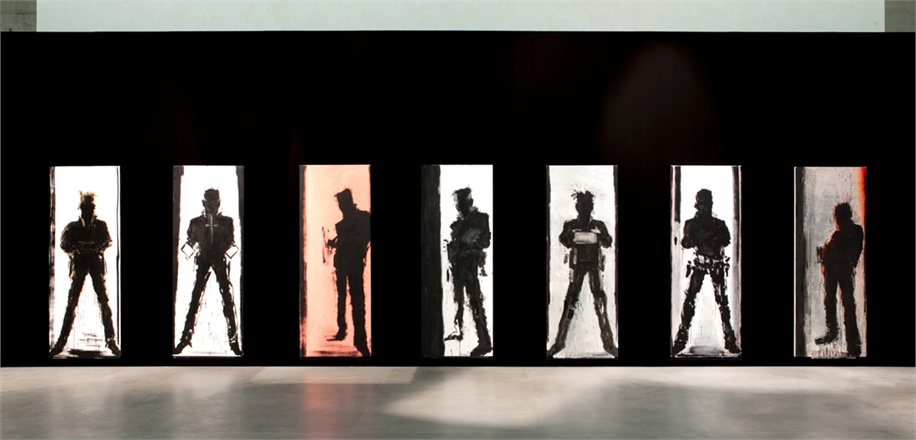
It was a bit of a sad spectacle: all the famous models sipping from their champaign, with their backs turned to the Hambleton paintings, talking and having a good time, while the maestro was lying in the gutter making these paintings, suffering from a monumental addiction and living in a rundown studio.
When Hambleton entered the building he looked a bit bewildered and stunned (his face also seemed to fall apart).
Richard Hambleton, a shadow at a blitz party.
I think Hambleton is a massively talented painter: his Marlboro man (long before Richard Prince made them) from the eighties, his seascapes (he actually once said: "I don't paint landscapes or seascapes, but escapes."), the cats, the jumpers, the heads, the rodeo paintings, the shadow man, the blood drawings, the beautiful paintings - I love them all.
For once, I thought, while watching all the models passing by, this man should remain on the street, far away from the maddening crowd, the upper class, the à¼ber rich, the models and the billionaires in their fancy clothes, not because I don't grant him money or fame, but because I never saw a man so out of place, so out of context, as in that 'show' in Phillips de Pury.
But lets return to Hambleton, en end this post with the man himself.
Here he is talking here to CNN about his comeback.
I love the punchline...
